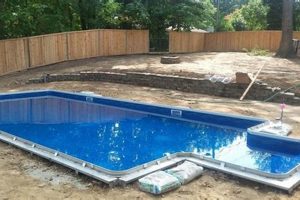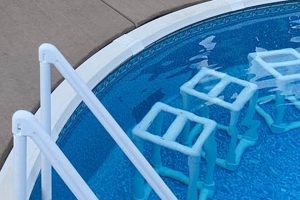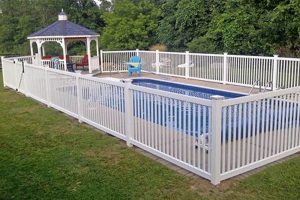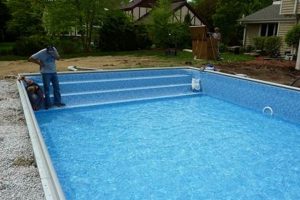A self-constructed system designed to harness the sun’s energy to elevate the water temperature in a swimming pool exemplifies resourcefulness. These setups, often built with readily available materials, offer an alternative to conventional heating methods. An example involves utilizing black plastic piping on a roof to absorb solar radiation and circulate pool water through it.
The significance of such an approach lies in its potential for cost savings and reduced environmental impact. By leveraging solar power, reliance on fossil fuels or electricity for pool heating diminishes. Historically, individuals and communities have sought out sustainable solutions, and creating a personal solar pool heating system represents a modern embodiment of this pursuit, aligning with energy independence goals.
The subsequent discussion delves into practical aspects of creating these systems, examining design considerations, material selection, performance expectations, and potential challenges encountered during construction and operation. Furthermore, the analysis will incorporate safety measures, regulatory compliance, and long-term maintenance strategies.
Construction and Implementation Guidance
The subsequent guidance addresses critical aspects of building and utilizing a system that heats a swimming pool using solar energy and self-directed assembly methods. Adherence to these points will enhance the system’s effectiveness and longevity.
Tip 1: Accurate Site Assessment: Prior to commencing construction, conduct a thorough assessment of the installation location. Factors such as sunlight exposure, roof angle, and shading patterns directly affect system efficiency.
Tip 2: Optimal Collector Placement: Maximize solar energy absorption by orienting the collector array towards the equator. Adjust the angle of inclination based on geographical latitude to capture peak solar radiation during swimming season.
Tip 3: Proper Material Selection: Utilize durable, UV-resistant materials for all components exposed to the elements. Black polyethylene or polypropylene piping offers a balance of cost-effectiveness and thermal performance.
Tip 4: Efficient Circulation Design: Implement a circulation system that minimizes hydraulic resistance and ensures uniform water flow through the collector array. A dedicated pump may be required to overcome head loss.
Tip 5: Temperature Monitoring and Control: Integrate temperature sensors and a differential controller to regulate water flow based on solar energy availability and pool temperature. This prevents overheating and maximizes energy gain.
Tip 6: Leak Prevention and Sealing: Employ robust sealing techniques and pressure testing to prevent water leaks throughout the system. Leaks diminish efficiency and can cause structural damage.
Tip 7: Regular Maintenance and Inspection: Conduct routine inspections of all components, including collectors, piping, and pumps. Remove debris, address leaks promptly, and maintain proper water chemistry to prevent corrosion.
Tip 8: Local Codes and Regulations: Before commencing construction, research and comply with all applicable building codes and regulations related to solar energy systems and plumbing installations. This ensures safety and legality.
These tips represent key considerations for building a functional and effective system. Diligent application of these principles will contribute to a cost-effective and sustainable pool heating solution.
The ensuing section explores advanced design techniques and optimization strategies for improved performance and energy savings.
1. Cost-Effectiveness
The economic viability of a self-assembled solar pool heating system hinges on its ability to offer a financially sensible alternative to conventional heating methods. Cost-effectiveness is a primary driver for individuals considering this option, and it encompasses several contributing factors.
- Reduced Energy Consumption Costs
The most immediate benefit is the reduction in recurring energy expenses. Traditional pool heaters, powered by gas or electricity, incur significant monthly bills. By harnessing solar energy, the reliance on these costly energy sources diminishes substantially, leading to long-term savings.
- Lower Initial Investment Compared to Professional Installation
A self-installed system generally involves a lower upfront investment compared to professionally installed solar pool heaters. Sourcing materials independently and performing the installation work eliminates labor costs, resulting in considerable financial advantages.
- Tax Incentives and Rebates
Government-sponsored incentives, such as tax credits and rebates, can further enhance the financial appeal. Many regions offer financial assistance to homeowners who adopt renewable energy solutions, thereby lowering the overall investment.
- Maintenance and Repair Considerations
While initial savings are attractive, long-term maintenance costs must be factored in. Although a self-built system might require less complex maintenance procedures, the potential for self-performed repairs, using readily available and inexpensive components, can still reduce long-term operational costs.
By effectively addressing the elements detailed above, DIY solar pool heating systems can present a compelling economic alternative for pool owners. It is imperative to carefully weigh the initial investment against potential long-term savings and consider applicable incentives to determine the true cost-effectiveness of such a system.
2. System Efficiency
The operational effectiveness of a self-constructed solar pool heating unit is fundamentally linked to its capacity to convert solar radiation into usable thermal energy for heating pool water. The level of efficiency directly influences the rate at which the pool heats up, the maximum attainable temperature, and the overall cost savings realized over time. Maximizing this efficiency is a critical objective in the design and implementation process.
- Collector Design and Material Selection
The design and materials of the solar collector are paramount in capturing and retaining solar energy. Black surfaces, known for their high absorptivity, are commonly employed. Collector designs vary, from simple flat-plate collectors using coiled black tubing to more complex designs incorporating glazing or reflectors to concentrate sunlight. The thermal conductivity of the material directly influences heat transfer to the circulating water. Improper material choice or inadequate insulation can lead to significant heat loss, reducing overall efficiency.
- Flow Rate Optimization
The rate at which water circulates through the collector system affects heat transfer efficiency. A flow rate that is too slow can result in overheating within the collector, leading to convective and radiative heat losses. Conversely, a flow rate that is too fast may limit the amount of heat absorbed by the water as it passes through the collector. Determining the optimal flow rate, based on collector design, surface area, and solar irradiance levels, is crucial for maximizing thermal energy gain.
- System Insulation and Heat Loss Mitigation
Minimizing heat loss throughout the entire system is essential for maintaining high efficiency. Insulating pipes and connectors, especially those exposed to the elements, reduces conductive heat loss. Properly sealing connections and joints prevents air leaks, which contribute to convective heat loss. The location of the collector and piping also impacts heat loss; for example, positioning the collector in a sheltered area or running pipes through insulated channels can improve overall system performance.
- Orientation and Tilt Angle
The angle and direction in which the collector is positioned significantly affects the amount of solar radiation it receives. Orienting the collector towards the equator maximizes exposure to sunlight throughout the year. Adjusting the tilt angle based on the geographical latitude and seasonal variations further optimizes solar energy capture. Inadequate orientation or tilt can result in reduced solar irradiance and lower system efficiency.
Therefore, the efficiency of a self-built solar pool heating system is a multifaceted attribute, contingent upon optimized design, careful material selection, and precise operational parameters. Addressing these facets comprehensively is pivotal for achieving a system that effectively harnesses solar energy and delivers cost-effective pool heating.
3. Material Durability
The longevity and consistent performance of a self-constructed solar pool heating system are directly contingent upon the durability of the materials used in its construction. Material degradation due to prolonged exposure to ultraviolet radiation, fluctuating temperatures, chemical interactions with pool water, and physical stress constitutes a primary cause of system failure. Therefore, the selection of robust, weather-resistant materials is paramount for achieving a reliable and enduring solar pool heating solution. Inferior materials necessitate frequent repairs or complete system replacement, negating the initial cost savings associated with a do-it-yourself approach. For instance, using non-UV-resistant PVC piping for the collector array will lead to embrittlement and cracking over time, compromising the system’s structural integrity and thermal efficiency.
Specific components, such as the collector surface, piping, and connection fittings, demand particular attention to material durability. Collectors often utilize black polyethylene or polypropylene tubing due to their inherent resistance to UV degradation and chemical corrosion. The piping system requires materials capable of withstanding both internal water pressure and external environmental factors. Connection fittings must provide a secure, leak-proof seal, even under thermal expansion and contraction. Examples of durable material choices include EPDM rubber for roofing applications and stainless steel for critical plumbing connections. The practical significance lies in minimizing maintenance requirements, reducing the likelihood of costly repairs, and ensuring that the system functions effectively for an extended period, thereby maximizing the return on investment.
In summary, material durability is not merely a desirable characteristic but a fundamental requirement for a successful “diy solar pool heater”. The selection of appropriate, high-quality materials mitigates the risks associated with environmental degradation and physical wear, ultimately ensuring the long-term functionality and economic viability of the system. Neglecting this aspect can lead to premature system failure, increased maintenance costs, and a diminished return on investment, undermining the core objective of a self-constructed, cost-effective pool heating solution.
4. Location Optimization
The geographical placement and physical positioning of a self-constructed solar pool heating system are critical determinants of its overall performance. Effective location optimization maximizes solar energy absorption and minimizes energy losses, contributing significantly to system efficiency and cost-effectiveness. Careful consideration of site-specific characteristics is essential for harnessing the full potential of a do-it-yourself solar pool heater.
- Solar Irradiance Levels
Solar irradiance, or the amount of solar radiation received per unit area, varies based on latitude, climate, and seasonal patterns. Areas with higher average solar irradiance offer greater potential for energy capture. For example, systems located in the southwestern United States will generally exhibit superior performance compared to those in northern regions with more cloud cover. Detailed solar irradiance maps and historical weather data are essential tools for assessing the suitability of a given location.
- Orientation and Tilt Angle
The orientation of the collector array relative to the sun’s path significantly impacts energy capture. Optimal orientation typically involves facing the collector towards the equator (south in the Northern Hemisphere, north in the Southern Hemisphere). The tilt angle, or the angle of the collector relative to the horizontal plane, should be adjusted to maximize solar exposure during the swimming season. A common guideline is to set the tilt angle equal to the local latitude. However, seasonal adjustments may be necessary to compensate for changes in the sun’s declination angle.
- Shading Analysis
Obstructions such as trees, buildings, or other structures can cast shadows on the collector array, reducing the amount of direct sunlight received. A thorough shading analysis is necessary to identify potential shading problems throughout the year. This analysis may involve using tools such as a solar pathfinder or conducting on-site observations. Corrective measures may include relocating the collector, trimming trees, or utilizing reflectors to redirect sunlight towards the collector surface.
- Proximity to Pool and Plumbing
The distance between the collector array and the swimming pool impacts pumping requirements and heat losses. Shorter distances minimize the length of piping needed, reducing both the energy required to circulate water and the amount of heat lost to the environment. Optimizing the plumbing layout and utilizing insulated pipes further reduces heat losses, improving overall system efficiency. Careful planning can significantly reduce pumping energy consumption and enhance the cost-effectiveness of the system.
The aforementioned factors demonstrate that location optimization is not a trivial consideration but rather an integral component of a high-performing “diy solar pool heater”. A comprehensive understanding of solar irradiance, orientation, shading patterns, and proximity to the pool allows for a tailored system design that maximizes energy capture, minimizes losses, and ultimately enhances the overall efficiency and economic viability of the heating system. Proper site assessment and strategic planning represent essential first steps in the successful implementation of such a system.
5. Safety Protocols
The integration of rigorous safety protocols is not merely advisable but fundamentally necessary when undertaking the construction and operation of a do-it-yourself solar pool heater. The inherent risks associated with electrical components, plumbing systems, and rooftop installations demand strict adherence to established safety guidelines to prevent injury and ensure the longevity of the system.
- Electrical Safety and Grounding
Improper wiring and inadequate grounding pose significant electrocution hazards. All electrical connections must comply with local electrical codes, utilizing appropriately sized wiring and protective devices such as ground fault circuit interrupters (GFCIs). Grounding the system minimizes the risk of electrical shock in the event of a fault. A common example involves ensuring that all metallic components, including pumps and control panels, are properly connected to a grounding electrode. Neglecting these precautions can lead to severe electrical injuries or even fatalities. The implications for a do-it-yourself installer are magnified due to the absence of professional oversight.
- Plumbing System Integrity and Pressure Testing
High water pressure within the plumbing system can lead to leaks, bursts, and potential structural damage. Prior to operation, the entire system must undergo thorough pressure testing to identify and rectify any weak points or leaks. Utilizing appropriate fittings and pipe materials rated for the expected operating pressures is crucial. An example includes employing pressure relief valves to prevent over-pressurization. Failure to adequately pressure test the system can result in significant water damage and potential injury from burst pipes or fittings.
- Rooftop Safety and Fall Protection
Installing a solar pool heater often requires working at elevated heights, increasing the risk of falls. Employing appropriate fall protection measures, such as harnesses, lifelines, and guardrails, is essential. Proper ladder placement and secure footing are also critical. A realistic example involves using a safety harness anchored to a secure point on the roof while installing the collector array. Ignoring fall protection protocols can result in serious injuries or even death. The do-it-yourself context amplifies this risk due to the lack of professional scaffolding and safety equipment commonly found on commercial worksites.
- Chemical Compatibility and Water Chemistry Management
The interaction between pool water chemicals and system components can lead to corrosion, material degradation, and potential health hazards. Ensuring compatibility between the materials used in the system and the chemicals present in the pool water is vital. Maintaining proper water chemistry, including pH levels and chlorine concentration, minimizes the risk of corrosion and scaling. An example includes using corrosion-resistant fittings and regularly testing the pool water to maintain appropriate chemical balance. Failure to address chemical compatibility can lead to premature system failure and potential health risks associated with water contamination.
These facets of safety protocols underscore their critical role in the successful and safe implementation of a “diy solar pool heater”. Strict adherence to these guidelines mitigates the inherent risks associated with electrical systems, plumbing, rooftop installations, and chemical interactions, ultimately ensuring the well-being of the installer and the longevity of the system.
6. Environmental Impact
The construction and utilization of a self-assembled solar pool heating system carry significant environmental implications. The primary benefit lies in the reduction of reliance on fossil fuels or electricity for pool heating, thereby diminishing the carbon footprint associated with conventional heating methods. The extent of this positive impact depends on the frequency of pool use, the efficiency of the solar heating system, and the displacement of alternative energy sources. For example, a homeowner who replaces a natural gas pool heater with a well-designed solar system can substantially reduce their annual greenhouse gas emissions. The practical significance of this shift lies in contributing to broader climate change mitigation efforts and reducing dependence on finite resources.
However, the environmental impact extends beyond operational energy consumption. The manufacturing and transportation of materials used in the construction of the solar heating system, such as plastics, metals, and pumps, contribute to environmental burdens. Careful material selection, favoring recycled or sustainably sourced components, can minimize these negative effects. Furthermore, the responsible disposal of system components at the end of their lifecycle is crucial to prevent pollution and resource depletion. A real-life example involves opting for collectors made from recycled polyethylene and ensuring proper recycling of pumps and controllers when they are no longer functional. The practical application of these principles promotes a more circular economy and minimizes the environmental footprint of the entire system lifecycle.
In conclusion, the connection between environmental impact and self-assembled solar pool heating is complex, encompassing both positive and negative aspects. While the displacement of fossil fuels offers a clear environmental advantage, the manufacturing and disposal of system components present challenges. A comprehensive understanding of these interconnected factors enables informed decision-making, leading to the selection of materials, construction practices, and operational strategies that maximize environmental benefits and minimize negative consequences. Furthermore, adherence to sustainable practices promotes responsible resource management and contributes to a more environmentally conscious approach to pool heating.
Frequently Asked Questions
This section addresses prevalent inquiries regarding the construction and utilization of self-assembled solar pool heating systems. The information provided aims to clarify common misconceptions and offer practical guidance for prospective installers.
Question 1: What is the typical cost savings associated with a self-constructed solar pool heater?
Cost savings are contingent upon several factors, including the size of the pool, the efficiency of the system, local climate conditions, and the cost of alternative heating methods. In general, expect a reduction in annual heating expenses ranging from 50% to 100% compared to conventional gas or electric heaters. Accurate calculations necessitate a detailed assessment of these variables.
Question 2: How long does it take to assemble a solar pool heating system?
Assembly time varies based on the complexity of the design, the skill level of the installer, and the availability of materials. A basic system utilizing readily available components may be completed within a weekend. More complex designs involving custom fabrication and extensive plumbing modifications may require several days or weeks to finish. Thorough planning and preparation are crucial for minimizing assembly time.
Question 3: What are the primary maintenance requirements for a system?
Regular maintenance includes inspecting for leaks, cleaning the collector surface, and maintaining proper pool water chemistry. Periodic flushing of the system may be necessary to remove debris and mineral deposits. The pump and controller should be inspected annually and serviced as needed. Neglecting routine maintenance can reduce system efficiency and lifespan.
Question 4: Does a solar pool heating system work in cloudy weather?
While solar pool heaters perform optimally under direct sunlight, they can still provide some heating benefit on cloudy days. Diffuse solar radiation can contribute to heat gain, although at a reduced rate. System performance is directly proportional to the amount of available sunlight. Consider supplemental heating options for periods of prolonged cloud cover.
Question 5: What are the primary challenges associated with a system?
Common challenges include optimizing system efficiency, preventing leaks, and ensuring structural integrity. Shading from trees or buildings can significantly reduce performance. Incorrect installation or improper material selection can lead to leaks and premature component failure. Careful planning, diligent execution, and adherence to best practices are essential for overcoming these challenges.
Question 6: Is professional assistance required for a “diy solar pool heater” construction?
Professional assistance is not strictly required but may be beneficial for individuals lacking experience with plumbing, electrical work, or rooftop installations. Consulting with a qualified professional can ensure compliance with local building codes and prevent potentially dangerous errors. Even if the majority of the work is performed independently, seeking expert advice on critical aspects of the installation is recommended.
The key takeaway is that while the creation of a self-assembled solar pool heater offers notable benefits, thorough research, meticulous planning, and adherence to safety protocols are essential for success.
The subsequent section will examine advanced topics, including system optimization techniques and integration with existing pool infrastructure.
Conclusion
The preceding analysis has explored the multifaceted nature of constructing and utilizing self-assembled solar pool heating systems. Key points encompassed cost-effectiveness, system efficiency, material durability, location optimization, safety protocols, and environmental impact. Each aspect contributes significantly to the overall viability and long-term performance of these heating solutions. Adherence to best practices, meticulous planning, and a thorough understanding of the underlying principles are essential for successful implementation.
The potential for reducing energy consumption and minimizing environmental impact positions this approach as a viable alternative to conventional pool heating methods. Further investigation into advanced system designs, smart controls, and integration with energy storage solutions may unlock even greater efficiency and sustainability. The careful consideration of all factors is warranted to ensure both economic and environmental benefits are fully realized.







